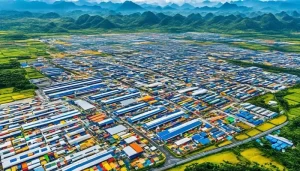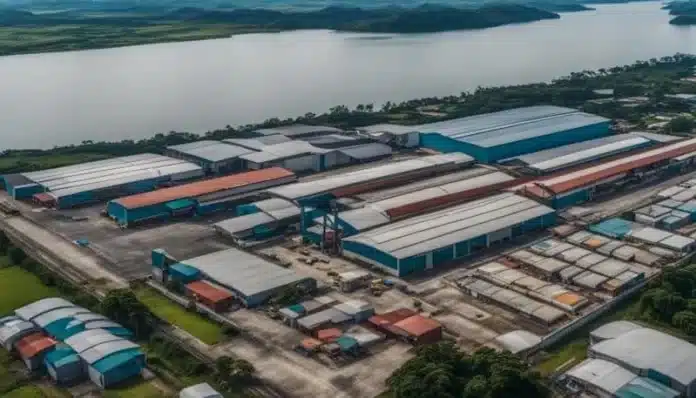Welcome to our article on the best warehouse locations in the Philippines for any industries. If you are looking to establish or expand your business operations in the country, it is crucial to choose the right warehouse location. A strategically selected warehouse can significantly impact the efficiency of your supply chain and overall business success.
At Hashmicro, we understand the importance of finding the best warehouse locations in the Philippines. We provide top-of-the-line warehouse management systems that can optimize your operations and streamline your logistics processes.
When considering warehouse locations in the Philippines, several factors come into play. Accessibility is key, as it ensures smooth transportation of goods and easy connectivity to key markets. Cost is another crucial aspect, as it directly impacts your bottom line. Additionally, economic factors, such as proximity to major industrial zones and logistical hubs, can have a significant influence on your business.
In the upcoming sections of this article, we will explore strategic distribution hubs in the Philippines, the importance of location accessibility, the pros and cons of urban vs. rural warehousing, the infrastructure of transportation networks, and future trends in warehouse site selection criteria. We will also touch on the significance of securing successful community relations and supporting the local tourism impact.
Whether you are in the retail, e-commerce, manufacturing, or any other industry, choosing the best warehouse location in the Philippines is vital for your business success. Join us as we delve deeper into the topic and provide valuable insights to help you make informed decisions.
Table of Contents
Warehouse Locations in the Philippines: Strategic Distribution Hubs
When it comes to choosing warehouse locations in the Philippines, strategic distribution hubs play a crucial role in ensuring efficient logistics and supply chain management. One of the most prominent distribution hubs in the country is Metro Manila, which serves as a prime choice for companies looking to establish their warehouses.
Metro Manila boasts a central location and excellent transportation infrastructure, making it an ideal distribution hub. Its strategic positioning allows businesses to easily access major ports, airports, and road networks, facilitating seamless movement of goods throughout the country.
When considering warehouse locations in Metro Manila, there is a choice to be made between urban and rural areas. Urban warehousing offers the advantage of proximity to customers and well-developed transportation networks, ensuring faster and more efficient delivery. However, it comes with the drawback of higher costs due to premium real estate prices and limited space.
Rural warehousing, on the other hand, provides lower costs and larger available land for warehouse facilities. This option might be suitable for businesses that prioritize affordability and have less dependency on immediate access to customers. However, rural areas may have limited transportation networks and infrastructure, which could affect the speed and efficiency of logistics operations.
Specific areas in Metro Manila that are popular for warehousing include Pasay City and Makati. These areas offer a strategic location and are well-connected to transportation networks, making them attractive choices for businesses in need of a strategic distribution hub.
Understanding Location Accessibility and its Economic Impacts
In the world of warehouse operations, location accessibility plays a crucial role in determining the success of your business. The geographic challenges of the Philippines, including diverse terrains and the constant threat of natural disasters, can have a significant impact on the accessibility of your warehouse.
When selecting a warehouse location, it is vital to consider these geographic factors and their potential economic impacts. The accessibility of your warehouse can affect various aspects of your operations, including transportation costs, delivery times, and overall efficiency.
Real estate trends should also be taken into account to ensure that your chosen location aligns with the current market conditions. Conducting a cost analysis is essential to evaluate the feasibility and profitability of your warehouse location choice.

By choosing a strategically accessible location, you can optimize your supply chain and reduce transportation costs. A warehouse located close to major transportation hubs and distribution centers can streamline your logistical operations, resulting in improved customer satisfaction and increased profitability.
Moreover, understanding the real estate trends and conducting a thorough cost analysis can help you make informed decisions about your warehouse location. It allows you to evaluate the long-term economic viability of your chosen location and make adjustments based on market demands.
Considering the challenges posed by geographic factors, staying updated on real estate trends, and conducting comprehensive cost analyses will enable you to select a warehouse location that maximizes accessibility and minimizes economic risks.
Urban vs Rural Warehousing: Analyzing the Pros and Cons for Industries
In the Philippines, when it comes to warehousing, there is a decision to be made between urban and rural locations. Each option comes with its own set of advantages and disadvantages that businesses need to carefully consider. Let’s explore the pros and cons of urban and rural warehousing in the Philippines.
Urban Warehousing:
Urban warehousing, with its close proximity to customers and robust transportation networks, offers several benefits for industries. By choosing urban locations, businesses can significantly reduce the time and expenses associated with transportation and delivery, ensuring faster and more efficient distribution of goods. The availability of various transportation modes, including ports, airports, and road networks, makes it easier for businesses to connect to markets both domestically and internationally.
However, urban warehousing also comes with its challenges. The cost of land and real estate in urban areas tends to be higher, which can be a significant consideration for businesses with limited budgets. Additionally, limited space in urban areas can pose challenges when it comes to expanding warehouse operations or storing larger volumes of inventory.
Rural Warehousing:
Rural warehousing, on the other hand, offers distinct advantages for businesses. Lower land and real estate costs provide cost savings, making it an attractive option for businesses looking to optimize their budget. The availability of larger land areas in rural locations also allows for more flexibility in warehouse design and layout.
However, rural warehousing does come with some challenges. The distance from major customer and transportation hubs can result in longer transportation times and higher logistics costs. Businesses operating in rural areas may need to carefully consider their transportation strategies to ensure smooth supply chain operations.
Economic Zones and Infrastructure Impact:
It is important to note that economic zones play a significant role in the warehousing landscape of the Philippines. Economic zones are designated areas that offer various incentives and benefits to businesses, such as tax exemptions and streamlined regulatory processes. These zones have a positive impact on warehousing operations by attracting industries and driving economic growth.
Additionally, the selection of either urban or rural warehousing can have a significant impact on infrastructure development. Urban warehousing requires infrastructure improvements and investments to support the increased flow of goods and materials, while rural warehousing can contribute to the development of infrastructure in previously underserved areas.
In conclusion, the choice between urban and rural warehousing in the Philippines depends on the specific needs and priorities of each business. The urban locations offer proximity to customers and well-developed transportation networks, while rural locations provide cost savings and flexibility in warehouse design. Consideration of economic zones and the impact on infrastructure further shapes the decision-making process. By carefully analyzing the pros and cons of each option, businesses can select the most suitable warehousing solution that aligns with their operational requirements and long-term goals.
Exploring the Infrastructure of Transportation Networks in Warehousing
In the realm of warehousing, an efficient transportation network is essential for smooth logistics operations and effective supply chain management. The infrastructure of transportation networks plays a crucial role in ensuring the timely movement of goods and materials throughout the Philippines.

Metropolitan areas, such as Metro Manila, are significant in providing access to key transportation hubs, such as ports and airports. These hubs serve as vital gateways for importing and exporting goods, both domestically and internationally. With the extensive transportation connections offered by metropolitan areas, businesses can optimize their logistical processes and reach customers more efficiently.
Moreover, logistics solutions and distribution centers contribute to improving the overall efficiency of warehousing operations. By strategically locating distribution centers in close proximity to major transportation routes, businesses can minimize transportation costs and streamline their supply chain. These distribution centers act as pivotal points for storing and distributing goods, ensuring timely deliveries to customers across the Philippines.
Considering the infrastructure of transportation networks is crucial when selecting a warehouse location. It allows businesses to assess the accessibility and connectivity of a potential site, determining its suitability for their specific logistics requirements.
Forecasting Future Trends in Warehouse Site Selection Criteria
In the evolving landscape of warehousing, understanding future trends in warehouse site selection is crucial for businesses in the Philippines. Anticipating and adapting to these trends can provide a competitive advantage and ensure efficient operations.
Real Estate Trends: Availability of suitable land and rental prices significantly influence warehouse location decisions. Staying updated on these trends helps businesses make cost-effective site choices.
Technology Advancements: Automation, robotics, and advanced analytics are transforming warehousing. These technologies boost efficiency, productivity, and accuracy, leading to better customer satisfaction and cost savings.
By integrating top warehouse management systems and advanced analytics, businesses can improve inventory management, demand forecasting, and order fulfillment, enhancing overall supply chain performance and customer service.
Adapting to these emerging real estate and technology trends is key for long-term success in the competitive warehousing industry. Check out HashMicro’s pricing schemes to find the right package for optimizing your warehouse operations.
Securing Successful Community Relations and Supporting Local Tourism Impact
Building and maintaining strong community relations is crucial for the success of warehousing operations in the Philippines. Positive relationships with local communities create a sustainable and resilient environment, helping facilities withstand potential disasters and ensure continuous supply chain operations.
Warehousing supports local tourism and economic development. Establishing warehouses in strategic locations creates job opportunities and contributes to the growth of surrounding areas, boosting tourism and improving residents’ quality of life.
In the Philippines, successful community engagement initiatives showcase the positive impact of warehousing. These initiatives promote disaster resilience by partnering with local authorities to implement emergency response plans and support community development projects in education, healthcare, and infrastructure.
To manage these complex operations efficiently, businesses can leverage advanced ERP solutions like HashMicro’s ERP software. Designed to streamline warehousing and supply chain management, HashMicro’s ERP ensures compliance with local regulations and enhances operational efficiency. With features tailored to Philippine businesses, HashMicro’s ERP supports effective community engagement and sustainable growth.
Discover how HashMicro’s ERP solutions can enhance your warehousing operations and contribute to community development in the Philippines. Join our free demo to see how our software can benefit your business.






































